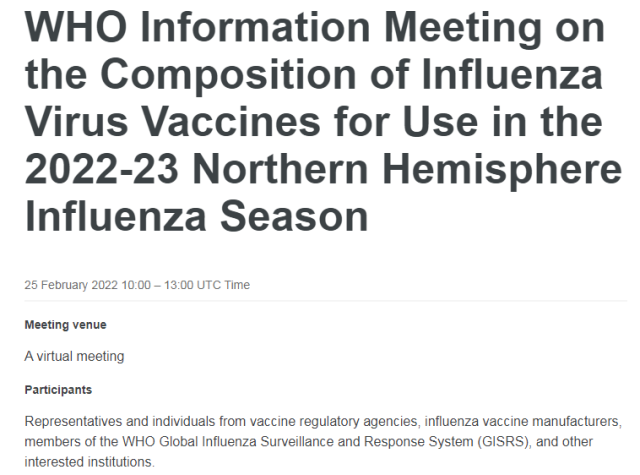WHO: Recommended components of seasonal influenza vaccine in the northern hemisphere for 2022-2023
- Normal Liver Cells Found to Promote Cancer Metastasis to the Liver
- Nearly 80% Complete Remission: Breakthrough in ADC Anti-Tumor Treatment
- Vaccination Against Common Diseases May Prevent Dementia!
- New Alzheimer’s Disease (AD) Diagnosis and Staging Criteria
- Breakthrough in Alzheimer’s Disease: New Nasal Spray Halts Cognitive Decline by Targeting Toxic Protein
- Can the Tap Water at the Paris Olympics be Drunk Directly?
WHO: Recommended components of seasonal influenza vaccine in the northern hemisphere for 2022-2023
- Should China be held legally responsible for the US’s $18 trillion COVID losses?
- CT Radiation Exposure Linked to Blood Cancer in Children and Adolescents
- FDA has mandated a top-level black box warning for all marketed CAR-T therapies
- Can people with high blood pressure eat peanuts?
- What is the difference between dopamine and dobutamine?
- How long can the patient live after heart stent surgery?
WHO: Recommended components of seasonal influenza vaccine in the northern hemisphere for 2022-2023
The World Health Organization (WHO) recently released the recommended components of the 2022-2023 Northern Hemisphere seasonal influenza vaccine . The details are as follows:
Conference background introduction
 Figure 1: Conference information on the WHO official website
Figure 1: Conference information on the WHO official website
Due to the high variability and uncertainty of influenza viruses, the viruses contained in influenza vaccines must be regularly updated to maximize the immune effect of the vaccine.
Since 1973, based on the information provided by the GISRS, WHO will organize a global meeting of relevant experts to analyze the data of the GISRS to confirm the activity of influenza.
Recommendations for influenza vaccine components for the next influenza season in the northern and southern hemispheres are made in February and September respectively, and these recommendations are made in the development, production and licensing of influenza vaccines by various national vaccine regulators and influenza vaccine manufacturers (pharmaceutical companies) It has important guiding role in other aspects.
Latest Influenza Vaccine Components
This meeting was held at 10:00 (UTC time) on February 25, 2022, and lasted 3 hours. At the meeting, WHO released the recommended components of the 2022-2023 Northern Hemisphere seasonal influenza vaccine:
Quadrivalent chicken embryo cultured vaccine
Class A/Victoria/2570/2019 (H1N1)pdm09 virus
Class A/Darwin/9/2021 (H3N2) virus
Class B/Austria/1359417/2021 virus (B/Victoria lineage)
Class B/Phuket/3073/2013 virus (B/Yamagata lineage)
Tetravalent cell culture or recombinant protein vaccine
Class A/Wisconsin/588/2019 (H1N1)pdm09 virus
Class A/Darwin/6/2021 (H3N2) virus
Class B/Austria/1359417/2021 virus (B/Victoria lineage)
Class B/Phuket/3073/2013 virus (B/Yamagata lineage)
Trivalent chicken embryo cultured vaccine
Class A/Victoria/2570/2019 (H1N1)pdm09 virus
Class A/Darwin/9/2021 (H3N2) virus
Class B/Austria/1359417/2021 virus (B/Victoria lineage)
Trivalent cell culture or recombinant protein vaccine
Class A/Wisconsin/588/2019 (H1N1)pdm09 virus
Class A/Darwin/6/2021 (H3N2) virus
Class B/Austria/1359417/2021 (B/Victoria pedigree)
knowledge about flu vaccine
① Human influenza viruses belong to the family Orthomyxoviridae, and are divided into types A (A), B (B), and C (C). Among them, influenza A and influenza B are the main causes of annual influenza outbreaks.
② Take “A/Guangdong-Maonan/SWL1536/2019 (H1N1)pdm09-like virus” as an example, the naming method refers to [type/location of isolation/strain number/year of isolation (subtype) 2009 pandemic -similar strains].
“pdm09” is added after H1N1 to show the difference, representing that it originated from the 2009 (09) pandemic (pdm) influenza virus. After 10 years of transmission, this strain replaced the original virus and became the mainstream H1N1 virus.
Like virus stands for similar strains, it represents not only one strain, but includes many similar strains.
At present, seasonal influenza vaccination is the most effective means to prevent seasonal influenza.
It can reduce a series of harms caused by influenza to the body and reduce the occupation of medical resources and the corresponding economic burden.
Therefore, I participate in the research and development of influenza vaccine production. The staff has a long way to go.
(source:internet, reference only)
Disclaimer of medicaltrend.org
Important Note: The information provided is for informational purposes only and should not be considered as medical advice.



